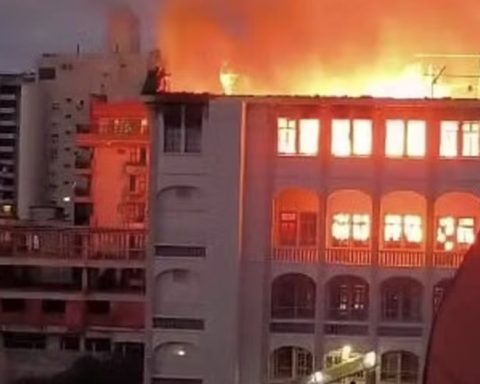The Secretary of Public Security (SSP) of the Mexican state of San Luis Potosí investigates a migrant smuggling network that charges between 8,000 and 10,000 dollars for the transfer to the border with the United States. Between Wednesday and Thursday they were arrested, as part of the first investigations, 135 foreigners, 22 of them Cubans.
“It is a criminal group that is carrying out transfers through gaps and some places to avoid the National Guard checkpoints,” he specified. 14ymedio state security spokesman Miguel Gallegos Cepeda. Coyotes arrive in towns and pass migrants off as tourists to avoid suspicion.
In a police tour of San Luis Potosí, in the community of Villa Hidalgo, last Wednesday they located five units that entered an embankment, for which they requested the support of the Army and the National Guard in the face of a possible event of ” drug trafficking”. According to information from the SSP, the drivers sped up to try to flee, but were intercepted by soldiers.
Six coyotes were traveling in the five units, all from the state of Puebla, who were transporting 30 migrants: 15 Cubans, including a family with children, 10 Nicaraguans and five Guatemalans. The drivers were arrested and transferred to the facilities of the State Attorney General’s Office, where an investigation was opened for migrant smuggling.
“It is a criminal group that is making transfers through gaps and some places to avoid the National Guard checkpoints”
“Caravans with dozens of Central Americans pass through the state. Now there are many Haitians who are being given work, but this type of transportation in vans and trucks is part of a network that is beginning to exploit the so-called Gulf route,” assures this newspaper Antonio, an agent of the Prosecutor’s Office.
From San Luis Potosí, explains the official, there are two options to get to the border with the US. The first route is to go to Monterrey and from there to Nuevo Laredo, on the Tamaulipas border with US territory, and the second is to go to Saltillo. , in the border state of Coahuila, and from there to Piedras Negras to try to reach Eagle Pass, in Texas.
The first inquiries located a group that operates in the vicinity of the Palenque archaeological zone, in Chiapas. “Part of this network takes the migrants to Coatzacoalcos, in Veracruz, interns them through the municipality of Tierra Blanca until they reach Orizaba and from there they go to Querétaro and continue until they reach San Luis Potosí,” Antonio emphasizes.
“The payment of 10,000 dollars is not for the transfer through Mexico but from the countries of origin. We hope to finish putting the puzzle together and dismantle this group,” explains the agent.
Last Thursday state police detected a truck that was driven at excessive speed in the Potosí municipality of Charcas. After a chase he was arrested on the section that connects the community of Matehuala with El Huizache. The back of the truck had two levels and was lined with sponge. 105 migrants were found in it: 28 from Guatemala, 21 from Honduras, 13 from El Salvador, 36 from Nicaragua and seven from Cuba.
“The payment of 10,000 dollars is not for the transfer through Mexico but from the countries of origin. We hope to finish putting the puzzle together and dismantle this group”
“This assurance ratified the modus operandi of this traffic network. The migrants mentioned that they paid $10,000 to reach the United States. The coyotes sold them the idea of up to three transfer opportunities, in case they were detained and returned to Guatemala.”
So far there are seven detainees by the trafficking network and investigations into the owners of the insured vehicles continue.
Meanwhile, in Yucatan, the Interceptor Patrol of the Mexican Navy rescued eight Cuban rafters, who were located in a boat 12 nautical miles from Puerto Progreso. After being treated by medical personnel, they were transferred to the remote terminal in Progreso where they were handed over to the National Institute of Migration.
________________________
Collaborate with our work:
The team of 14ymedio is committed to doing serious journalism that reflects the reality of deep Cuba. Thank you for joining us on this long road. We invite you to continue supporting us, but this time becoming a member of our newspaper. Together we can continue transforming journalism in Cuba.
















